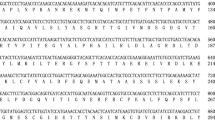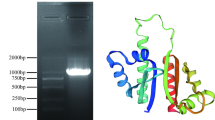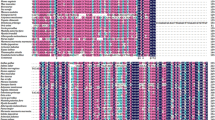Abstract
The tumor suppressor p53 is a sequence-specific transcription factor, whose target genes can regulate genomic stability, the cellular response to DNA damage and cell-cycle progression. In the present study, the full-length complementary DNA (cDNA) sequence of p53 gene from Penaeus monodon (Pmp53) was cloned by the technology of rapid amplification of cDNA ends (RACE). The cDNA of Pmp53 was 2239 bp, encoding a protein of 450 amino acids with calculated molecular weight of 50.62 kDa. The temporal expression of Pmp53 in different tissues (ovary, heart, intestine, brain, muscles, stomach and gills) and different developmental stages of ovary was investigated by real-time quantitative PCR (RT-qPCR). The lowest expression level of Pmp53 was observed in the stomach, while the highest expression level was detected in the brain. During the ovary development stages, the expression level of Pmp53 reached the peak at stage III. RNA interference (RNAi) and serotonin (5-hydroxytryptamine, 5-HT) injection experiments were conducted to study the expression profile of Pmp53 and PmCDK2 (cyclin-dependent kinase 2, CDK2). Knocked down of Pmp53 by dsRNA-p53 was sequence-specific and successful. Expression levels of Pmp53 and PmCDK2 in ovary of P. monodon were significantly increased at 12–96 h post 5-HT injection. These results indicate that Pmp53 may be involved in the regulation of ovarian development of P. monodon.







Similar content being viewed by others
References
Lane DP, Crawford LV (1979) T antigen is bound to a host protein in SV40-transformed cells. Nature 278(5701):261–263. doi:10.1038/278261a0
Vogelstein B, Lane D, Levine AJ (2000) Surfing the p53 network. Nature 408(6810):307–310. doi:10.1038/35042675
Lane DP (1992) Cancer. p53, guardian of the genome. Nature 358(6381):15–16. doi:10.1038/358015a0
Pietenpol JA, Tokino T, Thiagalingam S, Ei-Deiry WS, Kinzler KW, Vogelstein B (1994) Sequence-specific transcriptional activation is essential for growth suppression by p53. Proc Natl Acad Sci USA 91(6):1998–2002
Waldman T, Kinzler KW, Vogelstein B (1995) p21 is necessary for the p53-mediated G1 arrest in human cancer cells. Cancer Res 55(22):5187–5190
Xiong Y, Hannon GJ, Zhang H, Casso D, Kobayashi R, Beach D (1993) p21 is a universal inhibitor of cyclin kinases. Nature 366(6456):701–704. doi:10.1038/366701a0
El-Deiry WS, Tokino T, Velculescu VE, Levy DB, Parsons R, Trent JM, Lin D, Edward Mercer W, Kinzler KW, Vogelstein B (1993) WAF1, a potential mediator of p53 tumor suppression. Cell 75(4):817–825. doi:10.1016/0092-8674(93)90500-P
Bunz F, Dutriaux A, Lengauer C, Waldman T, Zhou S, Brown JP, Sedivy JM, Kinzler KW, Vogelstein B (1998) Requirement for p53 and p21 to sustain G2 arrest after DNA damage. Science 282(5393):1497–1501. doi:10.1126/science.282.5393.1497
Deng C, Zhang P, Wade Harper J, Elledge SJ, Leder P (1995) Mice lacking p21 CIP1-WAF1 undergo normal development, but are defective in G1 checkpoint control. Cell 82(4):675–684. doi:10.1016/0092-8674(95)90039-X
Lukin DJ, Carvajal LA, Liu WJ, Resnick-Silverman L, Manfredi JJ (2015) p53 promotes cell survival due to the reversibility of Its cell-cycle checkpoints. Mol Cancer Res 13(1):16–28. doi:10.1158/1541-7786.MCR-14-0177
Hollstein M, Sidransky D, Vogelstein B, Harrist CC (1991) p53 mutations in human cancers. Science 253(5015):49–53. doi:10.1126/science.1905840
Nevis KR, Cordeiro-Stone M, Cook JG (2009) Origin licensing and p53 status regulate Cdk2 activity during G1. Cell Cycle 8(12):1952–1963. doi:10.4161/cc.8.12.8811
Agarwal ML, Agarwal A, Taylor WR, Stark GR (1995) p53 controls both the G2/M and the G1 cell cycle checkpoints and mediates reversible growth arrest in human fibroblasts. Proc Natl Acad Sci USA 92(18):8493–8497. doi:10.1073/pnas.92.18.8493
Krause MK, Rhodes LD, Van Beneden RJ (1997) Cloning of the p53 tumor suppressor gene from the Japanese medaka (Oryzias latipes) and evaluation of mutational hotspots in MNNG-exposed fish. Gene 189(1):101–106. doi:10.1016/S0378-1119(96)00841-4
Liu M, Tee C, Zeng F, Sherry JP, Dixon B, Bols NC, Duncker BP (2011) Characterization of p53 expression in rainbow trout. Comp Biochem Physiol C Toxicol Pharmacol 154(4):326–332. doi:10.1016/j.cbpc.2011.06.018
Qi Z-H, Liu Y-F, Luo S-W, Chen C-X, Liu Y, Wang W-N (2013) Molecular cloning, characterization and expression analysis of tumor suppressor protein p53 from orange-spotted grouper, Epinephelus coioides in response to temperature stress. Fish Shellfish Immunol 35(5):1466–1476. doi:10.1016/j.fsi.2013.08.011
Ongvarrasopone C, Chanasakulniyom M, Sritunyalucksana K, Panyim S (2008) Suppression of PmRab7 by dsRNA inhibits WSSV or YHV infection in shrimp. Mar Biotechnol (NY) 10(4):374–381. doi:10.1007/s10126-007-9073-6
Treerattrakool S, Panyim S, Udomkit A (2011) Induction of ovarian maturation and spawning in Penaeus monodon broodstock by double-stranded RNA. Mar Biotechnol (NY) 13(2):163–169. doi:10.1007/s10126-010-9276-0
Su J, Oanh DTH, Lyons RE, Leeton L, van Hulten MCW, Tan S-H, Song L, Rajendran KV, Walker PJ (2008) A key gene of the RNA interference pathway in the black tiger shrimp, Penaeus monodon: identification and functional characterisation of Dicer-1. Fish Shellfish Immunol 24(2):223–233. doi:10.1016/j.fsi.2007.11.006
Wongprasert K, Asuvapongpatana S, Poltana P, Tiensuwan M, Withyachumnarnkul B (2006) Serotonin stimulates ovarian maturation and spawning in the black tiger shrimp Penaeus monodon. Aquaculture 261(4):1447–1454. doi:10.1016/j.aquaculture.2006.08.044
Vaca AA, Alfaro J (2000) Ovarian maturation and spawning the white shrimp, Penaeus vannamei, by serotonin injection. Aquaculture 182(3):373–385. doi:10.1016/S0044-8486(99)00267-7
Phinyo M, Visudtiphole V, Roytrakul S, Phaonakrop N, Jarayabhand P, Klinbunga S (2013) Characterization and expression of cell division cycle 2 (Cdc2) mRNA and protein during ovarian development of the giant tiger shrimp Penaeus monodon. Gen Comp Endocrinol 193(1):103–111. doi:10.1016/j.ygcen.2013.07.012
Phinyo M, Nounurai P, Hiransuchalert R, Jarayabhand P, Klinbunga S (2014) Characterization and expression analysis of cyclin-dependent kinase 7 gene and protein in ovaries of the giant tiger shrimp Penaeus monodon. Aquaculture 432(5):286–294. doi:10.1016/j.aquaculture.2014.05.022
Huang JH, Zhou FL, Ma ZM, Ye L, Jiang SG (2006) Morphological and histological observation on ovary development of Penaeus monodon from northern South China Sea. J Trop Oceanogr 25(3):47–52
Qiu L, Jiang S, Huang J, Wang W, Zhu C, Su T (2009) Molecular cloning and mRNA expression of cyclophilin A gene in black tiger shrimp (Penaeus monodon). Fish Shellfish Immunol 26(1):115–121. doi:10.1016/j.fsi.2008.03.022
Zhang D, Jiang J, Jiang S, Ma J, Su T, Qiu L, Zhu C, Xu X (2009) Molecular characterization and expression analysis of a putative LPS-induced TNF-alpha factor (LITAF) from pearl oyster Pinctada fucata. Fish Shellfish Immunol 27(3):391–396. doi:10.1016/j.fsi.2009.04.006
Altschul SF, Madden TL, Schaffer AA, Zhang J, Zhang Z, Miller W, Lipman DJ (1997) Gapped BLAST and PSI-BLAST: a new generation of protein database search programs. Nucleic Acids Res 25(17):3389–3402. doi:10.1093/nar/25.17.3389
Chen J, Liu P, Li Z, Chen Y, Qiu GF (2013) The cloning of the cdk2 transcript and the localization of its expression during gametogenesis in the freshwater giant prawn, Macrobrachium rosenbergii. Mol Biol Rep 40(8):4781–4790. doi:10.1007/s11033-013-2574-7
LI W-X, Huang H-Y, Huang J-R, Yu J-J, Ma J, Ye H-H (2013) Molecular cloning, expression profiles and subcellular localization of cyclin B in ovary of the mud crab, Scylla paramamosain. Genes Genomics 35(2):185–195. doi:10.1007/s13258-013-0077-5
Livak KJ, Schmittgen TD (2001) Analysis of relative gene expression data using real-time quantitative PCR and the 2−ΔΔCT method. Methods 25(4):402–408. doi:10.1006/meth.2001.1262
Ongvarrasopone C, Roshorm Y, Panyim S (2007) A simple and cost effective method to generate dsRNA for RNAi studies in invertebrates. ScienceAsia 33(1):35–39. doi:10.2306/scienceasia1513-1874.2007.33.035
Xianzong W (2013) Expression change of genes involved in Litopenaeus vannamei RNA interference under challenge of six double-stranded RNAs. D. Northwest A&F University, Xianyang
Charoensapsri W, Amparyup P, Hirono I, Aoki T, Tassanakajon A (2009) Gene silencing of a prophenoloxidase activating enzyme in the shrimp, Penaeus monodon, increases susceptibility to Vibrio harveyi infection. Dev Comp Immunol 33(7):811–820. doi:10.1016/j.dci.2009.01.006
Qian Z, Liu T, Liu Q, He S, Liu Y, Hou F, Wang X, Mi X, Cai C, Liu X (2014) p53 is involved in shrimp survival via its regulation roles on MnSOD and GPx in response to acute environmental stresses. Comp Biochem Physiol C Toxicol Pharmacol 159:38–51. doi:10.1016/j.cbpc.2013.09.009
Lamb P, Crawford L (1986) Characterization of the human p53 gene. Mol Cell Biol 6(5):1379–1385. doi:10.1128/MCB.6.5.1379
Hou C-C, Yang W-X (2013) Characterization and expression pattern of p53 during spermatogenesis in the Chinese mitten crab Eriocheir sinensis. Mol Biol Rep 40(2):1043–1051. doi:10.1007/s11033-012-2145-3
Qiu GF, Yamano K, Unuma T (2005) Cathepsin C transcripts are differentially expressed in the final stages of oocyte maturation in kuruma prawn Marsupenaeus japonicus. Comp Biochem Physiol B Biochem Mol Biol 140(2):171–181. doi:10.1016/j.cbpc.2004.09.027
Qiu GF, Ramachandra RK, Rexroad CE 3rd, Yao J (2008) Molecular characterization and expression profiles of cyclin B1, B2 and Cdc2 kinase during oogenesis and spermatogenesis in rainbow trout (Oncorhynchus mykiss). Anim Reprod Sci 105(3–4):209–225. doi:10.1016/j.anireprosci.2007.03.005
Visudtiphole V, Klinbunga S, Kirtikara K (2009) Molecular characterization and expression profiles of cyclin A and cyclin B during ovarian development of the giant tiger shrimp Penaeus monodon. Comp Biochem Physiol A Mol Integr Physiol 152(4):535–543. doi:10.1016/j.cbpa.2008.12.011
Dai W, Fu M, Zhao C, Zhou F, Yang Q, Wang Y, Shi J, Qiu L (2015) Molecular cloning and expression analysis of CDK2 gene from black tiger shrimp (Penaeus monodon). South China Fisheries Science 11(2):1–11. doi:10.3969/j.issn.2095-0780.02.001
Caplen NJ, Parrish S, Imani F, Fire A, Morgan RA (2001) Specific inhibition of gene expression by small double-stranded RNAs in invertebrate and vertebrate systems. Proc Natl Acad Sci USA 98(17):9742–9747. doi:10.1073/pnas.171251798
Tseng D, Chen Y, Kou G, Lo C, Kuo C (2001) Hepatopancreas is the extraovarian site of vitellogenin synthesis in black tiger shrimp, Penaeus monodon. Comp Biochem Physiol A Mol Integr Physiol 129(4):909–917. doi:10.1016/S1095-6433(01)00355-5
Urtgam S, Treerattrakool S, Roytrakul S, Wongtripop S, Prommoon J, Panyim S, Udomkit A (2015) Correlation between gonad-inhibiting hormone and vitellogenin during ovarian maturation in the domesticated Penaeus monodon. Aquaculture 437:1–9. doi:10.1016/j.aquaculture.2014.11.014
Bai H, Qiao H, Li F, Fu H, Sun S, Zhang W, Jin S, Gong Y, Jiang S, Xiong Y (2015) Molecular characterization and developmental expression of vitellogenin in the oriental river prawn Macrobrachium nipponense and the effects of RNA interference and eyestalk ablation on ovarian maturation. Gene 562(1):22–31. doi:10.1016/j.gene.2014.12.008
Kulkarni GK, Nagabhushanam R, Amaldoss G, Jaiswal RG, Fingerman M (1992) In vivo stimulation of ovarian development in the red swamp crayfish, Procambarus clarkii (Girard), by 5-hydroxytryptamine. Invertebr Reprod Dev 21(3):231–239. doi:10.1080/07924259.1992.9672242
Kruiswijk F, Labuschagne CF, Vousden KH (2015) p53 in survival, death and metabolic health: a lifeguard with a licence to kill. Nat Rev Mol Cell Biol 16(7):393–405. doi:10.1038/nrm4007
Schavolt KL, Pietenpol JA (2007) p53 and ΔNp63α differentially bind and regulate target genes involved in cell cycle arrest, DNA repair and apoptosis. Oncogene 26(42):6125–6132. doi:10.1038/sj.onc.1210441
Acknowledgments
This study was supported by The Special Fund for Fisheries-Scientific Research of Guangdong Province (A201300B03), Key Science and Technology Plan Projects of Hainan Province (ZDXM2014057), Special Scientific Research Funds for Central Non-profit Institutes (2014TS12,2015YD05), and The Guangdong Provincial Science and Technology Program (2014A020208039).
Author information
Authors and Affiliations
Corresponding author
Additional information
Wenting Dai and Lihua Qiu contributed equally to this work.
Rights and permissions
About this article
Cite this article
Dai, W., Qiu, L., Zhao, C. et al. Characterization, expression and silencing by RNAi of p53 from Penaeus monodon . Mol Biol Rep 43, 549–561 (2016). https://doi.org/10.1007/s11033-016-3988-9
Received:
Accepted:
Published:
Issue Date:
DOI: https://doi.org/10.1007/s11033-016-3988-9




